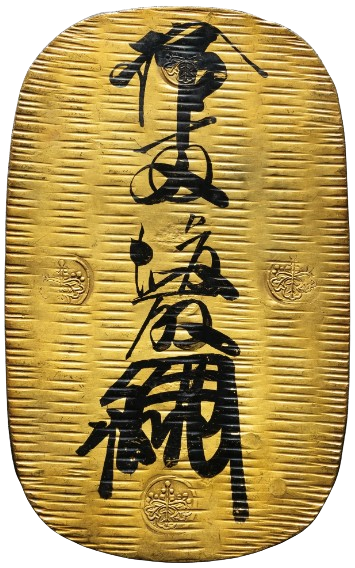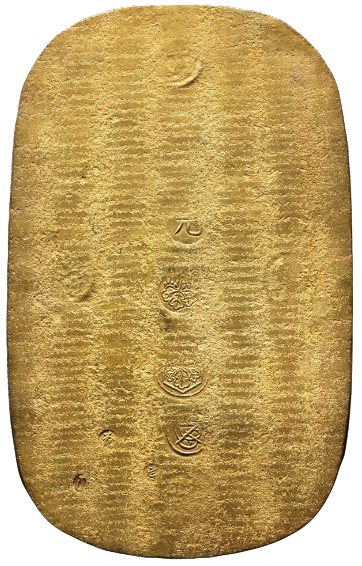Genroku Ōban Kin
(元禄大判金)


(Ginza Coins Collection, Tokyo. Reproduction authorized. © All rights reserved.)
At the end of the 17th century, Japan faced a deep economic crisis, worsened by the decline in gold and silver extraction and a succession of natural disasters, including the Edo earthquake (1703), the eruption of Mount Fuji (1707), and a smallpox epidemic in the Kantō region (1709). These events severely strained the finances of the Tokugawa shogunate under the leadership of Tokugawa Tsunayoshi. In an attempt to address the monetary contraction, Minister Ogiwara Shigehide implemented a reform that involved issuing new gold coins with a metal content reduced by 20%. Although this measure initially had an expansive effect on the economy, it undermined confidence in the monetary system. Merchants hoarded older coins of higher purity and turned to alternative credit systems, triggering a parallel economy less dependent on the devalued official currency. The social impact was significant: citizens and farmers accumulated durable goods or hid precious metals, indicating a deep systemic distrust. Popular discontent and intellectual pressure, personified by Arai Hakuseki, led to Ogiwara’s dismissal in 1712 and a policy reversal under Tsunayoshi’s successor, Tokugawa Ienobu, followed by Ietsugu. The new coin issues of 1714 aimed to restore monetary quality but triggered severe deflation, affecting the agricultural sector in particular. Within this context emerged the controversial production of the Genroku Ōban, coins of great symbolic value but inconsistent quality and often subject to counterfeiting. Their current rarity makes them valuable material evidence of an era marked by financial instability, political change, and widespread social tensions.
| Coin Name | Genroku Ōban Kin |
| Japanese Inscription | 元禄大判金 |
| Historical Period | Edo Period (1603-1868 d.C.) |
| Year of Minting | 1695 – 1716 d.C. |
| Chronological Reference | Japan |
| Minting Location | Edo, Kyoto |
| Issuing Authority | Clan Tokugawa (Tokugawa Tsunayoshi) |
| Function | Officially minted Value 10 Ryō |
| Material | Gold (67.6 %) Silver (32.4 %) |
| Shape | Oval |
| Height | 15.3 cm |
| Width | 9.4 cm |
| Weight | 165 g |
| Manufacturing Technique | Manual casting and hammering |
| Obverse Text and Symbols | Sigillo Gosan Kiri inscritto in un cerchio Scritta Jū Ryō壹両 (10 Ryō con numero stile Daiji) Firma produttore Ōbanza Gotō Gotō Renjō (後藤廉乗) |
| Reverse Text and Symbols | Inscription: Gen 元 indicating the era Free-standing Gosan Kiri seal Gosan Kiri seal inscribed in a rhombus and in a circle Kao in formal style (Jishin Horitsuke Ban) * Gokuin seals of the producers |
| Calligrapher / Artist: | Gotō Renjō |
| Museum References | |
| Number of Known Specimens | Very rare; only a few specimens preserved |
* In addition to the character Shigeru 茂, one of the following character pairs is also found:
| 七九 | さ九 | 宇九 | 山九 | 坂九 |
Sources and Bibliography
The Gold of Tokugawa, Alberto Rolfini 2025
瀧澤武雄, 貨幣 Takizawa Takeo, Kahei Nipponshi sho Hyakka 1999
